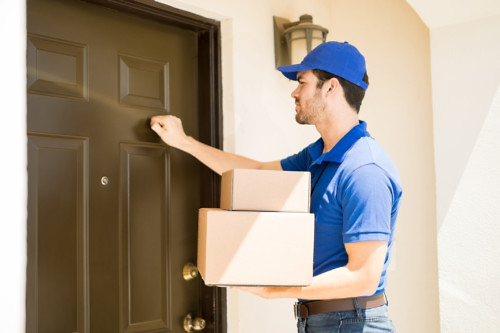
Amazon started as an online bookstore in 1994 and has since gradually redefined culture with its groundbreaking products and services. The Kindle introduced eBooks, Echo set a new bar for voice assistants, and their purchase of Whole Foods Market made history in the retail industry. But the sheer volume of their online shipments has made them what they are, shipping over 5 billion items worldwide in 2017 through their Amazon Prime membership program. I place orders on Amazon frequently and my packages are usually delivered outside my front door mid-morning while I’m at work. Consequently, I spend the next six hours hoping nobody steals it before I get home. This hasn’t happened to me yet, but sadly it is a recurring problem for many others in America. A report from InsuranceQuotes says that 23% of Amazon Prime members have had a delivered package stolen. Amazon recognizes this and unveiled its latest system to prevent package theft: Amazon Key.
Amazon Key, available exclusively to Prime members, allows deliverymen to briefly unlock your front door and slip your packages inside. You start by ordering a kit that includes a smart lock, indoor security camera, and the smartphone app. When you order select items on Amazon Prime, you can choose the “in-home delivery” option. Then when the package is delivered, the driver knocks on the door and if nobody answers, they scan a unique key code on the package to unlock the door and drop the package inside. You get notified of the delivery in real time through the app and can watch it live through the security camera.
As you probably suspect, some people are not thrilled with the idea of this. Survey results show only 31% of consumers are willing to use Amazon Key. The system raises lots of questions. What if they go inside to use the bathroom? What if you have a pet? What if they forget to lock the door? For starters, Amazon says the delivery drivers they hire are “thoroughly vetted, with comprehensive background checks and motor vehicle records reviews.” If your property is at all damaged from the delivery, they will fix it for you. The drivers are not allowed to actually enter the house. And if they did, you would know because you would see it through the webcam. The camera has a two-way audio system, so you could even chime in to say “Hey, get out of my house!” They are also not allowed to leave the premises until the door is successfully locked. As far as pets, Amazon doesn’t recommend in-home delivery if you have them and they won’t unlock the door if they hear barking.
Tech columnist Geoffrey A. Fowler from The Washington Post tried Amazon Key in his home. He complimented the Amazon delivery drivers for their discretion. They opened the door just enough to slide in the package and made sure it was locked before leaving. He even left a plate of cookies inside the door, but none of them took one. The Amazon workers are fully aware they’re under digital surveillance and respect the rules. But on one delivery, Fowler’s smart lock jammed. Amazon sent an installer to help and determined it was a problem with his decades-old deadbolt, which they weren’t authorized to fix. Fowler also had a problem with the delivery times. When using Key, Amazon is supposed to notify you of a four-hour window when your package will arrive, but Fowler said they missed that window four times. He also criticized how the smart lock can’t be accessed by any business other than Amazon. This means the USPS, UPS, or FedEx cannot do in-home deliveries even if they deliver items purchased from Amazon.
Amazon plans to expand Key to more than just package deliveries. Prime members could also use it to let cleaning services, dog walkers, or friends into their home when they’re not there. The question is, will the convenience outweigh the knowledge that a stranger has access to your house?
